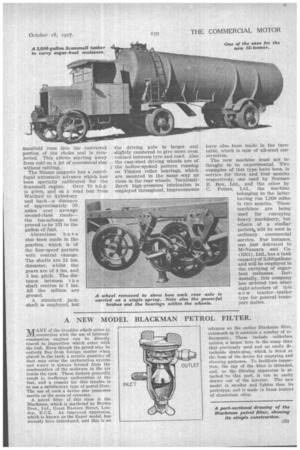AN EIGHT-WHEELED TRACTOR-LORRY.
Page 60

Page 61

If you've noticed an error in this article please click here to report it so we can fix it.
Built to Carry 15-ton Loads, the Latest Scammell Product has a Trailer Unit with Four Wheels on Two Axles, Each of Which is Mounted on a Single Semi-elliptic Spring.
MUCH attention is being directed by hauliers to the possibilities of further increasing the load capacity of vehicles, and•to do this it is essential to spread the load over more wheels. One of the most popular means for heavy haulage is the Scammell tractorlorry, and it will be of interest to many of our readers to know that a new type of flexible multi-wheeler has just been placed upon the market by Scaramell Lorries, Ltd., 14, Holborn, London, E.C.1.
This does not in any way replace the standard flexible six-wheeler, but is an extension of the range designed to accommodate greater load, the actual useful-load capacity being 1i9 tons.
Paints in the Newlodell.
The most striking difference in the new model naturally lies in the trailer portion, the rear of which is supported by four wheels arranged in line across the chassis. They are carried in pairs on short axles, each of the axles in turn having a single underslung semi-elliptic spring pinned at the front end and running in double slippers at the rear. To enable each axle to rock crosswise the spring-pin and spring c38 slide 'brackets are fulcrumed on stout pins carried horizontally and in the longitudinal line of the chassis, by heavy brackets bolted to the frame side-members and reinforced by cross-tubes passing to the corresponding brackets at the other side of the chassis. The arrangement is such that each rear axle is entirely independent of the other, and the individual wheel of each pair can lift by tilting its axle, thus at least halving the lift on the chassis frame and providing a remarkable degree of flexibility, whilst at the same time the four rear wheels can carry a much heavier load. This being the case, it is possible to place the line of the axles farther forward, giving a shorter wheelbase without overloading the individual wheels.
• The springs are 6 ins, wide and of ample length, and the wheels are supported on Timken taper-roller bearings. An important point in the construction is that each set of bearings forms a unit with its wheel, as the inner races are carried on a steel sleeve having its own adjusting nut. These sleeves slide over the ends of the axle proper, where each is locked by a hut, and to prevent any risk of rust
ing on to the axle they are copper plated. The wheels can be removef' without uncovering the bearings and if required, the bearings can bE adjusted while the wheels are off the axles. The oil-retaining felt washers are also carried in the wheel sleeves.
Four-wheel Braking.
A brake drum is provided on each wheel so that four-wheel braking IS obtained. The shoes on each pair of wheels are expanded by two cams operated by a single lever, and to give greater efficiency the cam spindles work on Hyatt roller bearings.
The frame is stayed and an adjustable central tensioner of the screw-jack type is employed, but actually the frame is not highly stressed, because of the reduced overhang.
Improvements have been incorporated in the tractor unit. The engine compression is somewhat higher, Specialloid pistons are used and a Claudel-Hobson carburetter is employed in conjunction with a special Claudel-Hobson manifold, which embodies three choke tubes. Each of these tubes is drilled so that any petrol deposited in the
manifold runs into the restricted portion of the choke and is reinjected. This allows starting away from cold on a jet of economical size without spitting.
Alterations h a v e also been made in the gearbox, which is of the four-speed pattern with central change. The shafts are 21 ins. diameter, whilst the gears are of 4 ins. and 5 ins. pitch. The distwice between t h e shaft centres is 7 ins. All the splines are ground.
A standard jackshaft is employed, but the driving axle' is larger and slightly cambered to give more even contact between tyre and road. Also the cast-steel driving wheels are of the hollow-spoked pattern miming on Timken roller bearings, which are mounted in the same way as those in the rear wheels. TecalemitZerck high-pressure lubrication is employed throughout. Improvements have also been made in the turntable, which is now of all-steel construction. .
The new machine must not be thought to be experimental. Two examples of this type have been in service for three and four months respectively, one used by Norman E. Box, Ltd., and The other by C. Peters, Ltd., the machine belonging to the latter having run 7,000 miles in two months. These machines are being used for conveying heavy machinery, but others of a similar patter% will be used in ordinary commercial service. For instance, one just delivered to McNamara and Co. (1921), Ltd., has a tank capacity of 3,000 gallons and will be employed in the carrying of sugarbeet molasses. Incidentally, this company has ordered two other eight-wheelers of this n ow tractor trailer type for general transport duties.












































































































